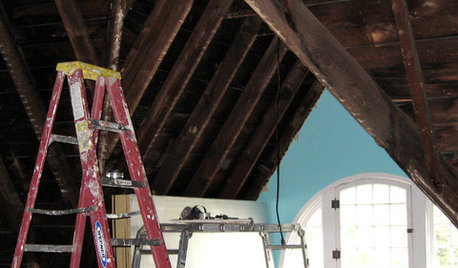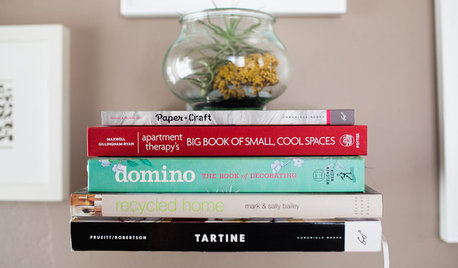I am currently bokashi-ing!
My bokashi bran came in the mail today and I have three small bins started in the garage. I have been saving a lot of scraps in anticipation, so hopefully once I get some volume reduction, I can combine these three and focus. FOCUS!
No question - just wanted to share - although if this generates a discussion, that would be great because I'm obviously a newbie.
Comments (54)
ifraser25
12 years agoWe are lucky here in that here in Brazil there a substantial Japanese community and bokashi is available commercially. It's a terrific product. Good luck with your own efforts.
ralleia
12 years agoThank you for the link, Wayne! And thank you Robert for the newspaper Bokashi method.
Have: newspaper, rice, old milk, molasses (gotta get the bottle back from mom), and ziplock bags.
Will Bokashi!
Wayne--do you think that the results of a homemade effort can be used in the septic, too? And I've never been entirely convinced of the "need" to add bacteria to the septic anyway--the experts seem divided right down the middle on the subject. In several attempts to research the subject I still haven't found anything really conclusive.
Related Professionals
Reading Landscape Architects & Landscape Designers · Saint Charles Landscape Architects & Landscape Designers · Gainesville Landscape Contractors · Wakefield Landscape Contractors · Fort Worth Landscape Contractors · Holtsville Landscape Contractors · Lynwood Landscape Contractors · Mequon Landscape Contractors · Webster Groves Landscape Contractors · Northlake Landscape Contractors · Aberdeen Decks, Patios & Outdoor Enclosures · Crystal Lake Decks, Patios & Outdoor Enclosures · Markham Decks, Patios & Outdoor Enclosures · Port Saint Lucie Decks, Patios & Outdoor Enclosures · Richmond Decks, Patios & Outdoor Enclosuresrobertz6
12 years agoThe mentioned link was to a retail site Teraganix, selling EM products.
They list EM - type products/stuff as:
EM1- Effective Microorganisms
Activated EM (maybe also called EM2?)
EM5
EM Bokashi -- perhaps the one most composters would be
interested inand there are other variations
One is a EM/Weed tea mix of some sortI have found most of my EM/Bokashi info with an external Search "Recipe for EM Bokashi".
Seems like there is quite a void between scientific papers and opinions expressed on the web. I would be interested in hearing about simple experiments gardeners have tried using regular compost, vermicomposting, and EM/Bokashi stuff. Right now I'm thinking of starting four basic EM formulas -- white rice water and newspaper, three varieties of rice water and newspaper, white rice water with newspapers/sawdust/wheat flour, three varieties of rice water with with newspapers/sawdust/wheat flour. The only thing I've had to purchase so far is a bottle of Blackstrap Molasses.
wayne_5 zone 6a Central Indiana
12 years agoralleia,
I'm not certain about what you mean by: "do you think that the results of a homemade effort can be used in the septic, too?"
Septic systems vary a lot in size, percolation, gallon useage, soaps, greases, and chemicals. I like to be on the safer side and cut down on gallonage dumped down the drain and also keeping grease to a minimum and using less soap. If I use some cleaner/chemical, I like to use a bucket and then dump the solution on the crushed stone driveway.
I only experienced a backup in the system in 1980. I suspect that slime coated the outlet holes of the drainage pipes. I was not using bacteria/enzyme/grease eaters then. I started using them then and would not want to be without now.
robertz6
12 years agoMontcal --
I started two cultures of the EM serum. So far my expenses have been a bottle of Blackstrap molasses and gallon of skim milk -- $8. The rice water I took off the rice when preparing it for dinner. White rice for one mix, the other had white, long grain, and brown rice.
On the fifth day of sitting, I filtered off the liquid and added ten parts of skim milk.
Looks like molasses will be the main expense. Container will be the square bucket and lid that comes with kitty litter.
robertz6
12 years agoMontcal-
How is you fermenting going? Since it has four weeks since you first posted, have you finished a batch?
I made three serums, and today moved the purified serum to the media. In addition to newspaper, tried brown grocery bags, sawdust, wood chips less then 1/4", and old rye flour.
Have a bunch of kitty litter containers for air tight storage. I may try two buckets at once for comparison, if enough material is available. Total cost was bags $3.00, molasses $6.00, and skim milk $5.00, or $14.00.
Wonder how mixing rice water, banana water, and garlic water would work?
robertz6
12 years agoThe third stage of serum was finished a few days ago, and I've filled my first Bokashi bucket. I sealed in up, put it downstairs, and covered with a black trash bad (growing seedlings there so the lights are on).
Everything looks OK, the bags smelled like cider vinegar as Newspaper Bokashi guy said it would. The only hard part was separating the layers of newspaper. I used newspaper and sawdust as the media to hold the serum. Two weeks for inoculation of newspaper and four for sawdust??
When the bucket is finished in about two weeks, I'll put half in the compost pile and half in a patch in the garden maybe four inches deep.
robertz6
12 years agoFinished two buckets of bokashi, one regular bucket and one dog bokashi. The regular one came out as expected, maybe more liquid in the bottom. I choose the one bucket with shredded paper in bottom. There was more liquid in the bottom than I expected, maybe because most of the material came from the freezer (thawed before using).
The dog bokashi bucket did not come out as soupy as expected. Next time I will use less sawdust in ratio to the dog poop. Also, think I will squish the dog nuggets first. I have a three stage process for the dog poop. First, the droppings are but into a bucket with some sawdust. Second, when the bucket is full or nearly full, the material is put into a bokashi bucket reserved just for dog poop. When the material is finished fermenting, say two to four weeks, it is added to a in-ground dog poop digester. A plastic container (old 100 # HTH can) is buried in the ground just below the surface. Holes are drilled in the bottom and lower six inches. Wood chips half fill the container, and wood chips also are outside the can and under it. Kinda of a leach field for a septic system. The screw top is kept on the container, only opened to deposit a bucket of dog bokashi. The wood chips outside the can has a clay cap below the surface to keep away odors.
Montcal, where are you? I hope you are still interested in bokashi. You started the thread.
Haname
12 years agoI have been doing bokashi for a while now, a DIY method. Buckets are good quality from a horse/feed store, doubled up. Inner bucket has holes drilled in the bottom. Outer bucket has a spigot for draining "bokashi juice." I purchased some Gamma lids from Amazon for easy on/off. I bought a plate at the local Goodwill and super-glued a ceramic drawer pull (from Home Depot) to the middle so I could use that to press down the contents.
For the bokashi, I bought some rice hulls cheap from a local home brew supply shop for my medium. The "EM" is homemade using kefir whey (could use yogurt whey too, any lacto-fermented whey would work fine). Also used molasses and mixed with water from my fish aquarium. This makes a perfectly good "EM-1" that I use to make the bokashi.
One thing I had difficulty with was the "bokashi juice." That stuff is GROSS. It STINKS. And there's too much of it to do anything useful. It is recommended to dilute it greatly and use it on plants but my bin, which is heavy on vegetable waste, generates lots of liquid and I don't really want to handle it. I recently learned how to reduce juice production. When adding food to the bucket, I lay a newspaper section on top after sprinkling with Bokashi, then put the plate on top. The newspaper absorbs excess liquid. The next day when adding to the bucket if the newspaper is still relatively dry I will use it again. When it gets too damp I remove it from the bucket and add to the regular compost, replacing it with a fresh section.
This greatly reduces the liquid draining to the bottom bucket and eliminates the need for me to deal with it. The bokashi compost itself doesn't smell bad to me. When the bucket is ready, I add it to the middle of my compost and it makes GREAT compost.
robertz6
12 years agoOn my first regular (non-dog poop bokashi bucket) I added two inches of fine shredded paper at the bottom. Because I was using a one bucket system instead of one bucket with drain, or two bucket system. The lecheate or liquid which gathers at the bottom can be used in the garden greatly diluted, or put down the house drain for cleaning purposes.
I don't think the liquid smells that bad. It is not quite as clean a scent as the media when it comes out of stage 3 (innoculation of media). This smells very much as one writer said, of cider vingear.
My philosphy is DIY as cheaply as possible, so I use newspaper as the media. Tried oak sawdust but only one of seven small containers smelled right. The newspaper media worked very well, easy to push the air out of zip lock bag. One or two bags did not smell right out of twenty total.
Will try a simple, not-too-blind test. Will put one bucket of bokashi in small area, next to non-fermented similiar ingredients, and third area of no extra material. May try spinach, lettuce. Probably not enough room and time to try under pepper and tomato plants.
robertz6
12 years agoI just finished filling my second regular bokashi bucket, meaning it should be ready to be transferred to the garden in two weeks. A trial bucket of garden stuff bokashi did not work out. Fresh grass, a few leaves, and some green needle branches produced a too dry, not very fermented smelling result.
Just moved to the inoculation stage of making a new serum based on a yogurt base. Did not know exactly how much to use, ended up with four cups of de-chlorinated water, half a cup of blackstrap molasses, and two tablespoon of a Greek-style yogurt. This method would knock down the creation stage by about three weeks. From five weeks with rice type down to two weeks.
emgardener
12 years agoForgive this probably naive question,
I've read about bokashi and that you are supposed to bury it in the ground after the fermenting.
So why go to all the trouble? Why not just bury your kitchen scraps in the ground right away without the fermenting step.
I've been doing this some. It does create a slurpy stinking mess in the ground, but it is covered up so you don't smell it (unless you dig it up to see what is happening).
Nearby plants seem to enjoy it. And I've read bokashi creates a stinky mess also in the ground.
So what is the advantage to bokashi?
robertz6
12 years agoOne can plant ten days after bokashi is introduced into the soil. Just regular fruit and veggie wastes would take longer to be usable to the soil.
When the bokashi material comes out of the bucket ready to the garden, it has a cider vinegar smell, not a putrid smell.
My large mesh bins take about four months to get to the finished compost stage. The bokashi bucket gets full in a week, then two weeks for the fermentation process, then its ready for the garden.
robertz6
11 years agoThe labor is more of a consideration than the small dollar costs of ziplock bags, blackstrap molasses, and skim milk.
Separating the paper media after 3rd stage Inoculation is the most work. I have found that the white pages phone book and Hemmings Motor News work better than regular newsprint. The size is also about right for using in a cat litter bucket.
It will take a few more months before I can say that bokashi has worked well for me. I have added two regular bokashi buckets into the gardening area, and one dog poop bokashi bucket into my DIY below ground dog poop digester.
My main decision to go with the newspaper bokashi as opposed to the commercially sold products is past experience in composting. I have bought rather expensive composting systems only to find that a simple DIY mesh bin works much better at a fraction of the price. If bokashi turns out to be more of a fad than a real improvement, at least I'll be happy none of my dollars went to someone else.
robertz6
11 years agoMy last Bokashi serum did not smell right after inoculation. There was hardly any odor. Instead of two week inoculation, I forgot about it and it aged four plus weeks. It was the first batch using yogurt material.
Have just inoculated a new batch using active yogurt, maybe this one will be more successful.
One question I have. When using bokashi made from different sources (say rice, yogurt, and garlic for example), can the materials be combined during the three stage process; or should they be made seperately, and the paper shredded and only mixed when adding to the bokashi bucket?
robertz6
11 years agoI finished my fifth Bokashi bucket this week. I've looked around the web for opinions on bokashi, but just found a couple of technical articles with mixed results.
Anyone care to voice an opinion of a possible test a small backyard gardener could do on the value of bokashi? One seasons tomato, pepper, spinach, onion yield versus yields of non-bokashi yields? Would more than one years results be necessary?
jannie.jan
11 years agoHi! First post here via a search for urban, indoor Bokashi composting toward keeping an initial potting soil investment nutritionally useful for an ongoing container garden.
Bokashi newbie, too, with first bucket planted two weeks today in a 15-gallon aluminum container layered with post-bunny hay, dirt, bucket contents, a handful of homemade Bokashi Beer Bran, 4" commercial garden soil, and more hay, covered ultimately with a piece of cardboard to keep the bunny out.
Today opened and turned the contents around with pretty good success IMO. See photo.
No foul odor, pests, etc., looks mostly like dirt except for the paper, egg shells, a few other still-recognizable pieces of this and that, and a corn cob that was--surprise--easily chopped with my little shovel.
I've added another handful of Bokashi Beer Bran (just because), and going to give it another week before introducing it to the 1' x 1' x 5' planter for a first experiment in planting.
Have diluted lecheate 1:100 and applied to various of the plants in container garden. No ill effects; no science, so can't tell if it was a good thing or not. Today, I used a less-diluted solution with fingers crossed on the spinach and bean containers.
Wondered why some of you endeavor to use yoghurt / kefir shortcuts for making the EM?
Call my Bokashi Bran 'Beer Bran' because I have a deal with my beer-brewing friend for what's left after his brews (bran/hops/rice hulls) to use as EM substrate. Working well so far! I get to share a growler of his latest brew and he gets Bokashi Beer Bran and dinner.

robertz6
11 years agoWell, I choose to make my own newspaper bokashi instead of buying one of the bran-based ones. Mainly because I hate to buy anything in case it turns out to be a pig in a poke. And bokashi has not proven itself as far as I can tell for the small gardener. There are lots of posts people say they have had good results, and some rather scientific studies where one crop was examined. But I'd rather see a few simple trials where backyard gardeners compared bokashi-laced areas with non-fermented wastes, growing say tomatoes, peppers and spinach.
Laurel Zito
11 years agoTo Robert, I don't know if there is a benefit compared to composing which is easier. What type of compost system did you buy that failed to work properly? You can say the name brand, was it a tumbler or one of those twin bin systems? I can tell what went wrong with that, but not anything about bokashi. You would have to compare tradition compost vs. bokashi to see if one was better. I would think if you used nothing vs bokashi, the bokashi would at least provide something useful to the plants.
robertz6
11 years agoI'm happy with my current composting system, the large open mesh bin. Cheap, easy to put up, easy to turn (at least if you don't go higher than 24 inches), fine for fish in the core, good heat retention for piles that were hot, etc.
But bokashi seemed to offer quicker benefits with the 14 day fermenting plus 10 days in garden soil. At least compared to the roughly four months it takes me to get what I consider workable compost.
I expect it will take at least another year to get a better idea if bokashi is a improvement over non-fermented compost. Have not noticed any increase in worms yet.
Laurel Zito
11 years agoBokashi won't increase worms. Worms like cold composting best. They want to eat things like fruits that are partially broken down, but not very broken down. Hot composting actually discourages worms. They like damp with with good drainage. In the summer if you are in a hot area, I don't know if they die or go dormant. For earthworms:
Temperature range: Minimum; 45 F, maximum; 85 F, ideal range; 55 to 65 F. They like loose soil, but if you dig too much you disturb their tunnels. They like fiber in the soil, not compacted soil. They like compost and a lot of it. They eat a lot and they more you have the more compost you will need to feed them. They love San Francisco because we are mostly about 60 in the summer.Laurel Zito
11 years agoDid you know earthworms are not native to the new world? In fact, you can get along fine without them in your soil. Just just will happen to come along if you are having good soil, as a by product, but are not at all critical to have a good soil. I like them as friendly turners of soil, but they are also eaters of compost, that might be better off without them. But you can't get rid of them, so what is one going to do? I just hate that people feel bad if they don't have a lot of worms.
Haname
11 years agoWondered why some of you endeavor to use yoghurt / kefir shortcuts for making the EM?
I use kefir whey because it works, it's free, and I know it's fresh. Making the bokashi bran is very easy and costs me very little. I do buy rice hulls at $1/lb. 5 lbs last me more than a year.
The bokashi liquid is something I really don't like to handle. It smells bad(I put lots of onion skins, garlic, seafood, lots of veggies in my bokashi). My bokashi produces a lot of liquid because there is lots of fruit/veg waste in there. I saw no benefit to the plants when using it. My solution is to cut the bottom out of the bucket and bury it in the ground so only the lid is above. I fill it and allow it to cure the requisite 2 weeks, then remove the bokashi to another airtight container layered with browns so it can break down. I have also put the bokashi in the middle of a compost pile, as well as digging the trench and burying it.
Burial isn't the best for our situation because the dogs are attracted. However, where we have buried bokashi, the worms have come, then left after the bokashi was consumed.
The most practical way I have so far found for dealing with the bokashi is to put it in the middle of compost, or layer it with dry browns in a closed container.
I also like to deodorize the buckets after using for bokashi. Fill with finished compost and after a couple of weeks, the bokashi pickle smell is gone.
Laurel Zito
11 years agoI did not think worms could eat liquids. They seem to gather around solid particles, but maybe they can eat liquids. Interesting thought. But, I have too many worms honesty, if you feed them a lot more, they create more eggs and you get even more worms and they eat your compost, and you get even more worms. It never ends. The more compost you put in the more the worms will increase in population.
Haname
11 years agoWorms eat bokashi; bokashi isn't liquid. Ingredients that have high water content, when cultured with bokashi bran, will release a lot of liquid. That liquid must be drained off from the bokashi or it will spoil. My in-ground bokashi bucket works well for me because the liquid produced drains away into the ground. The bokashi can then be removed from the bucket and buried where it will feed the wild worms. Some people also put bokashi in worm bins.
The worms in my garden bed left because the temperatures get so high here in the desert. it's a raised bed, not a good place for worms in the dry heat. While they were working the bokashi, they did multiply. I think it is cool year round in San Fran vs. very hot here in Phoenix in summer.
Laurel Zito
11 years agoYes, it's cool year around, my worms are active all year. The soil in phoenix is also very different. I did not know you could do it in the ground. I thought bokashi was a little machine for people with apartments. Or maybe a little bucket thing with a spout. But, if it drains how will it ferment? I guess you could ferment first then then later drain off the liquid to the ground.
Haname
11 years ago:) Bokashi is the bin system where you put in kitchen waste and an inoculant containing beneficial microorganisms to pickle it. The process prevents rot but changes the material in a way very similar to cabbage turning into kimchi or saurkraut. The tough plant parts are softened, and the material is full of beneficial microorganisms. This is why worms are so readily attracted to it. Bokashi is much easier for them to eat than fresh scraps.
But, if it drains how will it ferment? I guess you could ferment first then then later drain off the liquid to the ground.
The (expensive) manufactured bokashi buckets have a drain spigot that you open to allow the liquid to drain out. It doesn't affect the fermentation to drain it off. Bokashi is anaerobic, but the little bit of air that gets in when adding material or draining leachate doesn't interfere with the process as long as you don't dig around in there and open it too often, or open the lid while draining the liquid. If you want to see how people compost with bokashi I would recommend Youtube.
robertz6
11 years agoMy newspaper bokashi method seems to work well, although the drain needs some ironing out. Rather than buy a expensive bucket, I chose a DIY. Took a kitty litter bucket and added a low drain cut from a liquid laundry soap bucket. First tried sealing on with caulk, then runny two part epoxy. The caulk fell off when stressed, and the two part epoxy leaked. I still have some plumbers putty two part epoxy to try.
Someone had a cheap drain idea, with a couple parts from the hardware store. Think it was an idea from a bokashi thread on some other site.
My last bokashi batch was yogurt, but did not smell right when the ziplock bag was opened. The basic rice mix seems the most reliable.
Laurel Zito
11 years agoI have some plants that are too tough to compost, maybe I could soften them up. They will compost, but it such a pain they take a really long time like philodendron leaves. Can robert post the rice recipe that works? I have a rice cooker and, I can get started right way, using a plastic tub outside.
Haname
11 years agoBokashi is a process for managing kitchen waste, not so much yard waste. I would use a shredder on that sort of material if possible and compost it in a regular pile, and use as mulch.
Laurel Zito
11 years agoI don't have a shearer, unless I could use the paper sheared, but I think it would rust. If I had a garden sheared, I would shred branches, but the cost a lot, and I heard all kind of bad things about those chipper shredders. They were too difficult and always breaking down. Unless one can work on them as in being very handy with machines.
robertz6
11 years agoYou don't even need a rice cooker, Trop Thought!
I'll post the recipe next time. In the meantime, get some rain water, or let some tap water sit out in the air for a few days. You don't want the chlorine residual of fresh tap water to kill are the nice bacteria that do all the work.
robertz6
11 years agoYou don't even need a rice cooker, Trop Thought!
I'll post the recipe next time. In the meantime, get some rain water, or let some tap water sit out in the air for a few days. You don't want the chlorine residual of fresh tap water to kill your nice bacteria that do all the work.
Laurel Zito
11 years agoIt won't rain here until winter, mostly likely, but I will do that thanks. I always use hose water on compost does not see to hurt it.
robertz6
11 years agoI also use the hose to occasionally water a hot compost pile. It would be a pain to age water before adding it to the compost pile.
But, let me repeat, IMHO, I think it is very important to NOT use fresh tap water in bokashi. Let it sit for several day to dissipate the residual chlorine. We are talking about a gallon or so of water, so it is not the same volume as watering a compost pile. I fear your results will be unsatisfactory with bokashi using fresh tap water.
In both bokashi stages where water is used, it is 90% of the total mix. One never waters a compost pile 9 parts water to 1 part green/brown ingredients.
Laurel Zito
11 years agoThat does seem reasonable, but I don't have your rice recipe yet. I would age the water in a bucket first or use rain water that would be better, but it may not rain here for many months. I can wait. Or maybe distilled or spring water. I use spring water for my frog, because tap water kills.
robertz6
11 years agoOK, enough info to get you started on newspaper bokashi with rice water starter.
Most of this info is from wordpress.com, found by searching "newspaper bokashi recipe". This article says info is from "bokashicomposting.pdf".
If you have some molasses use that. If not, buy blackstrap molasses, said to be a bit superior for our use.
The water used should be chlorine-free, so if rain water is not available, let tap water sit for three days before using.
In the filtering, I use either a paper towel, or coffee filter.
MAKING SERUM
Stage 1: Making the basic serum, 5 to 8 days
Stage 2: Purifying the serum, two weeks
Stage 3: Transferring the serum to media, in our case newspaper. Two weeks
Dry the media, store, use as needed. Keeps 6 months to two years, depending on who you believe.USING SERUM
1) Make a bakashi bucket with newspaper serum and kitchen wastes. Takes two weeks after bucket is full.
2) Bury finished bucket material in soil, plant after ten days.Today, we'll go over Stage 1. This is a simple process, only drying the media takes much time.
Measure out half a cup of cheap white rice and one cup of the rain water. Put in a bottle or container you can shake hard for a minute. Separate the rice for cooking for your next meal, and put the water mix in a 3-5 cup plastic container. Place a paper towel on top instead of a lid, securing with a rubber band. Place in a dark location, wait 5-8 days.
Laurel Zito
11 years agothanks, I saved it. I don't don't when I will have a chance to try it, but thanks.
joegreenjeans
11 years agoI have made serum from scratch and liked doing the process to see if it would actually turn out, but don't plan on doing it again. Too time consuming. My neighbor and I simply split a bottle of EM Mother Culture and make bokashi and activated EM from that. I like knowing there are 13 or so strains of microbes in it for sure. With both have large gardens and compost piles too.
We usually just buy a 50 # bag of wheat bran for about $12.50 and go with that . I had the impression that the bran feeds the microbes better than something like sawdust or newspaper , but would like to hear more if anyone knows why some substrates are better than others.
Also, I did start off with newspaper bokashi but found that difficult to deal with since the papers stuck to each other so much. The wheat bran powder is so much easier.
One of the best things about keeping a bokasi bin going is that you can ferment just about anything, and you can empty the bin all at once when you are ready. In the past I would have to bury those fly attracting fruit and other wastes deep in my compost pile almost daily.
robertz6
11 years agoI choose paper for the bokashi media for several reasons:
1) Easy to squeeze the air and liquid out of ziplock bag with flat paper. I like the white pages or Hemmings Motor news over regular daily newsprint.
2) Found a good step by step guide for the newspaper method (see post a few posts back for website)
3) I'm cheap about somethings. And if bokashi turns out to be a gimmick, don't wish to patronize those promoting it.A note about my difficulties in affixing a DIY spigot to the bucket. When I saw mention of the ph of bokashi at around 2 or 3 (7 is neutral), figured out it was eating thru the caulk in a matter of hours.
joegreenjeans
11 years agoI think most beer/ wine making supply places sell cheap spigots meant to go on buckets. That's where I got one of mine. No leaks until the dog started chewing on it. Loves the bokashi juice.
robertz6
11 years agoMy dog also loves bokashi leachate, but then he will chew just about anything. If he swallowed 1/100th of 1% of what he chewed up, he would be deceased long ago.
Someone had a method of adding a cheap DIY spigot to a bokashi bucket, can't remember where I saw it.
We have a local store called Worm's Way that carries beer/wine supplies. They don't carry composting worms anymore -- can you believe that!
robertz6
11 years agoThe new dog has been digging up the fermented bokashi material in the garden yesterday and today. Must have been more attractive than the dry dog food in his dish both days, because he left dog food in his dish both times.
The bokashi was put eight inches down in the garden area a week ago. Tarp won't help. Maybe 1-1/2 inch thick heavy blocks/stone might.
joegreenjeans
11 years agoYou may have better luck and much faster decomposition too if instead of just trench burying the bokashi you thoroughly mix it with enough soil so all of the bokashi gets coated with a bit of soil, then cover it up. It might mean digging down a couple of inches more. I know this will reduce the overall odor and decomp speed should double
One more thing, if you by any chance are not draining off the juice in your bucket type, the odor of the bokashi will be a lot stronger, and more attractive to the dog.
robertz6
11 years agoJoe, I had mixed that bokashi material in with the soil. And during the indoor fermenting 14+ days, I drained the bucket every other day since there was no simple drain plug.
Yesterday another bucket went into the garden. This time I put a window screen frame over the top soil, and secured it with a few pieces of lumber.
In a effort to keep the dog from eating the soil and bokashi mix, I suppose one could save the bokahi leachate liquid and pour it over his dry (and unscented) food. But with a pH of around 3, it would not do much for his teeth. The stuff ate thru caulk and two part epoxy in less than a day.
joegreenjeans
11 years agoI used an 8 x2' piece of old wood trellis after my new dog started digging for the buried bokashi, but she didn't go after the next ones i buried.
Maybe she got used to the smell since I used the juice on my garden beds frequently, watering afterward so my wife didn't complainHU-14723003
10 months agoWhy Bokashi? Because Bokashi doesn't create greenhouse gasses! Because Food waste is the #1 item in our landfills! 24%! Food waste is responsible for 8-10% of our global greenhouse gasses! If you traditional hot compost perfectly you can cut down those Greenhouse gasses by 50% but with Bokashi it's 0 and has 100% carbon sequestration, 100% nutrient retention and it accepts all food stuff without having to manage proper levels of greens and browns etc. along with being faster it's much easier. Another important thing where I live, is that bears raccoons and rats aren't attracted to it. I brew my own EM with organic brown rice, koji rice, brown sugar and salt. I use a closed bucket, currently with additive free wood stove pellets in the bottom of my bucket to soak up the juices. it goes outside into stacking cedar rings instead of burying it because it's much easier to manage that way and we get lots of snow in the winter. During the winter months, I knock the snow off the lids, dump my bucket and use the finished bokashi as dirt from the bin next to it, to layer with. In the spring it melts and finishes just fine. At some point I am wanting to do an experiment with my home brew up against, homebrew without koji, home-flakes, water kefir, and store bought bran. I want to time lapse them side by side in gallon glass jars to see which one is the most effective.

















Haname